Posted by R. John Howe on 05-29-2007 06:18 AM:
A Bow to DOBAG
Dear folks -
As one goes down the Agean coast of Turkey, one
encounters the town of Ezine. Ezine is of interest at that point, primarily,
because the guide books warn that there are no ATMs in Assos further
on.
Going out of Ezine, toward Ayvacik, one is reminded that the outlet
for the DOBAG project is close by and we found it without difficulty.
The building is right off the road with a large parking lot and a
restaurant downstairs. We ate lunch, I drank my first Efe beer (not bad), and we
climbed the stairs to a large display room above.
The room is open with
a kind of stage area on the far end. There is a demonstration loom (with a
working weaver) set up on one side on the near end. Rugs are laid out on the
floor and the stage and one walks between them examing the project's work which
is for sale.
I liked, but didn't photograph, a rug, perhaps 3 X 5, but we
didn't know how we would get it home in our luggage. So instead we made our bow
to DOBAG by buying two simple, inexpensive bags with good color.
Here is
the front of the first one:
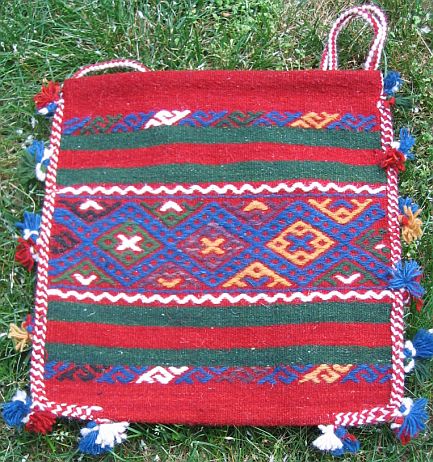
Its back:
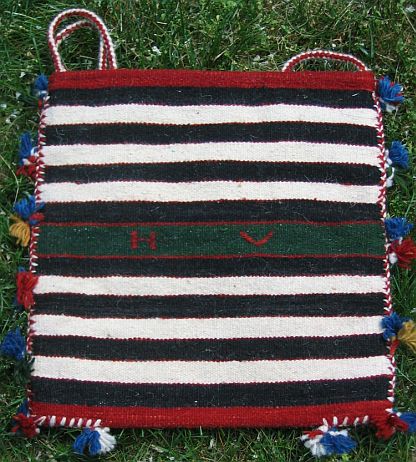
The front of the second:
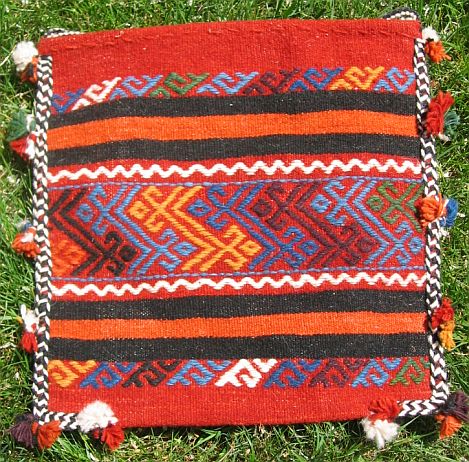
Its back:
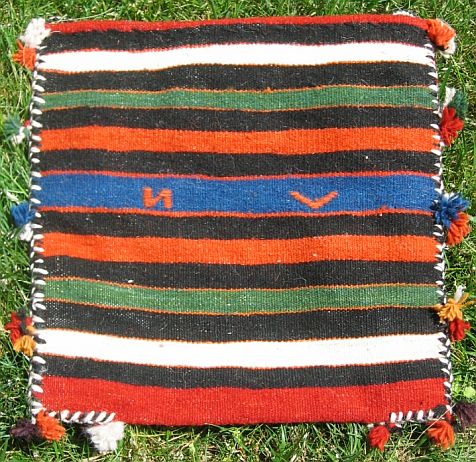
It is hard to exaggerate how
influential Harald Bohmer's work with the DOBAG project has been in getting
natural dyes used more frequently in rug weaving
today.
Regards,
R. John Howe
Posted by Marty Grove on 05-29-2007 08:53 AM:
Motivation
G'day John and all,
We can see the sometime roadway aging process is
an especially quick way to take off the rawness from new weavings but seriously, these beaut bags, their
natural colours glorious in a drab environment, brightening ones demenour is
their obvious intent.
but seriously, these beaut bags, their
natural colours glorious in a drab environment, brightening ones demenour is
their obvious intent.
DOBAG's are for the wide world, and it might be
unlikely they would be used in a carrying capacity in the West. With their
gentle fading over the years on the wall or chest, eventually they will
approximate the condition we especially like.
I especially liked the
orange dominant bag, to me it has a mellow whole and a comfortable design which
wouldnt be difficult to live with. Both are interesting examples of how
individual natural hues can be - Im sure each dyer attempts to make a
difference, which the weaver responds to.
They wouldnt look new like that
after a while with me John, they would just definitely need being used...
Regards,
Marty.
Posted by Ivan Sønderholm on 05-29-2007 01:12 PM:
Hi John
I visited the DOBAG Cooperative in Ayvacik in
2005.
Here is a photo of one of their rugs:
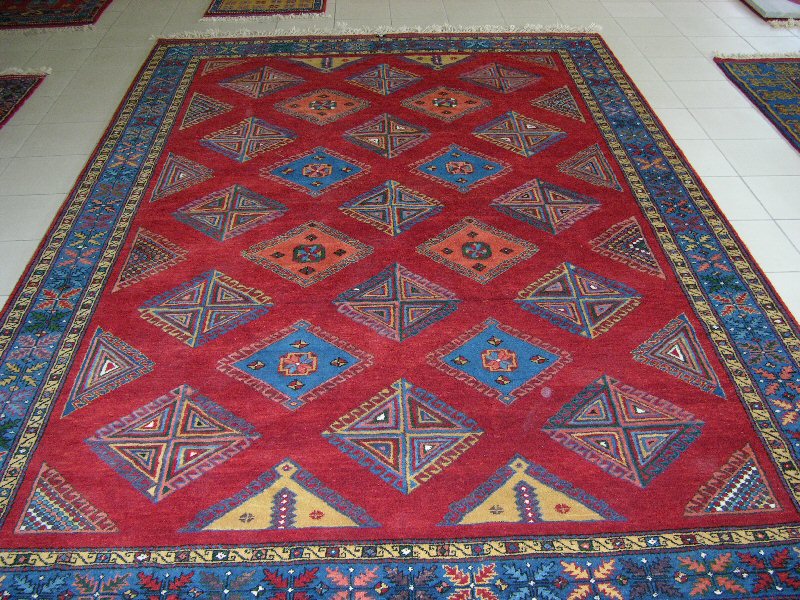
__________________
Best
regards
Ivan Sønderholm
Posted by Chuck Wagner on 05-30-2007 07:31 PM:
Hi John,
This will probably sound funny coming from me, but actually,
I find those bags particularly unattractive. To summarize: 
They are so incredibly garish
that, had you not told anyone, my bet would be that the "old" gang would be
carping loudly about bad synthetic jobs. I feel a little better knowing that
vegetal dyes and synthetics aren't always that hard to tell apart. Where is
Michael when I need him ?
Can't say I think very much of the piece that
Ivan shows us either; the stiff design and that dreary combination of red &
blue looks like Soviet era goods from Azerbaijian
Sorry; I do like
several of your other finds !
Chuck Wagner
__________________
Chuck
Wagner
Posted by R. John Howe on 05-30-2007 07:43 PM:
Hi Chuck -
Turkish rugs naturally dyed are not to everyone's taste.
Often Turk weavers choose color combinations that are, how shall we say it,
surprising at least. Someone said to me once that some Turkish color
combinations are something of an "acquired taste."
And these pieces don't
claim to be anything really, excepting an illustration of what can be done with
natural dyes. We see them as give away items for an appropriate
occasion.
I found the colors in them, face-to-wool, not at all
offputting, but would not press approval on anyone having a different
experience.
As I said to someone (I think off board) it's to a degree the
sort of thing that results in our all not being attracted to the same woman (or
man). And is that person ever glad.
Thanks for your frank thoughts. We
need to reach beyond good middle class manners in these
conversations.
Best,
R. John Howe
Posted by Chuck Wagner on 05-31-2007 08:57 PM:
Hi John,
Well, as you know (remember the thread on ORANGE ?), I'm not one to shrink from synthetic
dyes if I like the overall appearance of the piece. I do tend to stay away from
excessive saturation, but we do have one or two pretty intense pieces (our
Moroccan cape comes to mind...).
Thinking about it a little more, I think
what puts me off more than anything else is the uniformity of the colors and the
strong saturation. They're indicative of a well run vegetal dye production shop,
with good temperature control and a high level of consistency in the dye
preparation and the dyeing process. Not what we tend to seek in the rustic
pieces - no obvious abrash - and on the screen, the colors look a little
opaque.
So, hopefully, no offense taken. They're interesting in their own
right.
Regards,
Chuck Wagner
__________________
Chuck
Wagner
Posted by James Blanchard on 05-31-2007 09:47 PM:
Hi all,
I don't mean to be critical of any of these pieces per se, but
more than the strong orange and lack of abrash mentioned by Chuck, I find the
extensive use of light blue to be jarring. Is this just because I am more
acquainted with the palette of the Turkoman, Baluch and S. Persian weaving
groups? In any case, I think that all of these weavings would benefit from more
use of a strong, deep indigo.
This brings to mind another
issue...
I was under the impression that the DOBAG project used
traditional designs and colours, and yet even discounting the fact that they are
new, they don't look very "traditional" to me in terms of palette and/or design.
Is this because I am not familiar with the range of "traditional" colours and
designs on Turkish weavings?
James.
Posted by R. John Howe on 05-31-2007 11:09 PM:
James -
I do think that the DOBAG cooperative does generally weave
traditional Anatolian designs in natural colors (I don't know how closely
weavers are encouraged to follow traditional color usages).
Here is a
link to the site one California dealer who is involved in the DOBAG effort. He
provides some description of the character of the project.
http://www.returntotradition.com/html/dobag_project.html
It
is my understanding that pile rugs produced under the cooperative must be
submitted to a quality control board and approved before it can be sold as a
DOBAG rug. There used to be (perhaps still is) a leather label attached to each
approved DOBAG piece attesting to this approval.
These simple little
flatweaves did not have such labels attached. I don't think they are serious
DOBAG products, only inexpensive weavings that exhibit natural dye colors. I
don't know whether the designs on them are traditional, but they may well
be.
There may be others here with more experience with, and knowledge of
DOBAG than I.
I am surprised a bit at the seeming intensity of the
reaction to them. I saw them as pleasantly inoffensive. We may need to consider
more carefully who we give them to. 
Regards,
R. John Howe
Posted by James Blanchard on 06-01-2007 01:08 AM:
Hi John -
If you found my reaction intensely negative, then I
miscommunicated. However, I think this does raise a somewhat broader issue about
various projects which are trying to "recapture the past" with traditional
designs and natural dyes. Many seem not to be able to adequately capture the
essence and dynamism of the old weavings. Is this because they need to age a
bit, or because they have not used colour combinations effectively, or didn't
appreciate the importance of various forms of abrash? Whatever the case, I find
that some of these modern "traditional" producers leave me
underwhelmed.
James.
Posted by R. John Howe on 06-01-2007 09:47 AM:
Hi James -
I think it is true that often newer pieces do not, as you
say, "capture the spirit and dynamism" of some older material, but again, these
two modest little bags are not, to my mind an appropriate arena for that
test.
I own a contemporary Ersari carpet that has a mina khani design. I
actually had a hand in its creation, because I asked for the most saturated red
they could manage and a particular dark ground border that I especially liked.
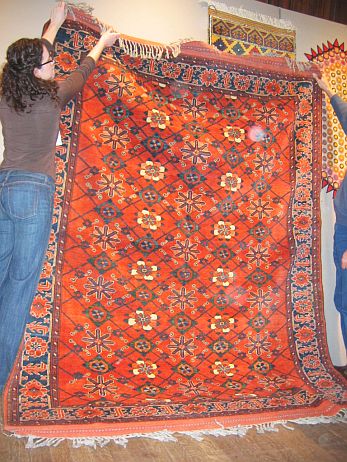
Closer
image
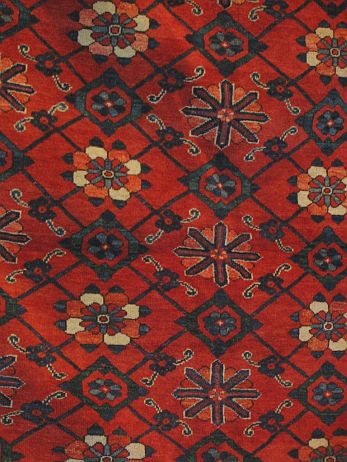
I
have recently shown this piece side by side with a 19th century Yomut main
carpet that I also own...
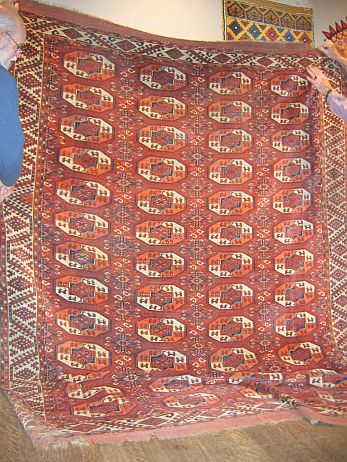
Closer
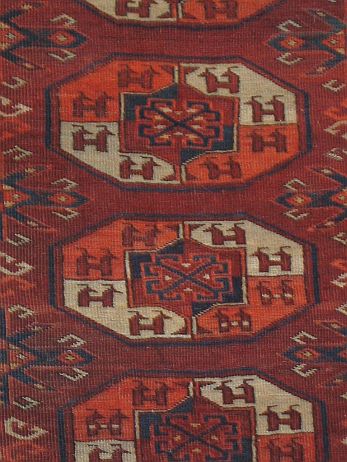
...and got offers to buy (yes) the Ersari. 
I've said this before but, have
you noticed that we collectors often seem a little inconsistent about our stated
color preferences?
Folks will ooh and and aah over the deeply saturated
colors of some 15th century Turkish piece, or something 19th century woven by
Turkmen, but then will also complain that colors are "too bright" and lack the
nice mild shades of many seasoned naturally dyed
pieces.
Regards,
R. John Howe
Posted by James Blanchard on 06-01-2007 11:28 AM:
Hi John,
I think your new Ersari is attractive too, and I am not
surprised that some might prefer it to the Yomut. I have more people remark on a
modern Khal Mohammadi or Afghan than a really nice old Shirvan or
Ersari.
I think you are right that it is not just the intensity or
saturation of the colours, but there is something else that seems evident for
those who like the natural colours of old weavings. My wife calls it a "je ne
sais quoi" quality, and a rug must have it before it is elevated to a desirable
status for her. I think many of us know what she means.
With regard to
some old rugs, I think we have to admit that collectors like them because they
are "collectible", not necessarily because they are stunningly attractive. I
have hummed and hawed about an antique Arabatchi main carpet with excellent wool
and pink and blue silk highlights, classic drawing (13 x 5 tauk nuska guls) and
colours, and in great shape. I know it is probably highly collectible and at a
seemingly good price, but I can't seem to get over the fact that it doesn't
really appeal to me aesthetically enough to purchase. Maybe I just haven't
progressed fully into the collector category.
James.
Posted by R. John Howe on 06-01-2007 11:38 AM:
James -
Oh no. There are lots of ugly old rugs.
Likely most of
them made in any given era were.
Some feel that "old" makes it more
likely that a rug we encounter now will be "better" because a kind of winnowing
process has gone on and the better old material has been retained more
frequently.
Regards,
R. John Howe
Posted by James Blanchard on 06-01-2007 12:15 PM:
Hi John,
I kind of like the "winnowing" theory that the small
percentage of rugs that were preserved for over a century might represent the
more attractive ones. Could that explain why so few Arabatchi rugs were
preserved???
James
Posted by Steve Price on 06-01-2007 12:29 PM:
Hi James
Maybe. But the alternative, that not many were made to begin
with, probably figures into the equation as well.
Regards
Steve
Price




 but seriously, these beaut bags, their
natural colours glorious in a drab environment, brightening ones demenour is
their obvious intent.
but seriously, these beaut bags, their
natural colours glorious in a drab environment, brightening ones demenour is
their obvious intent.





